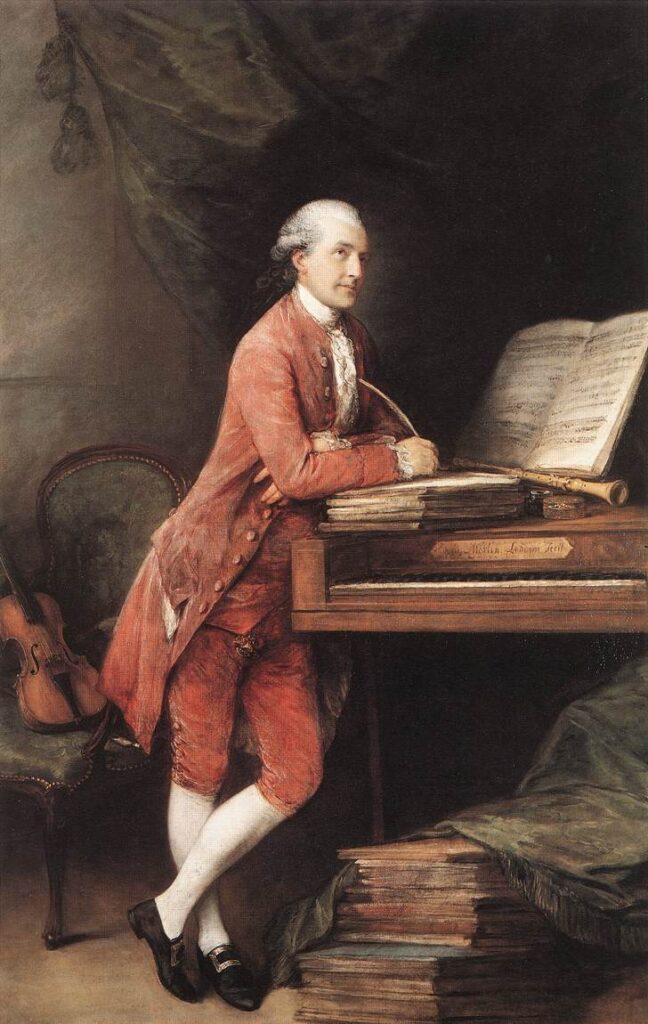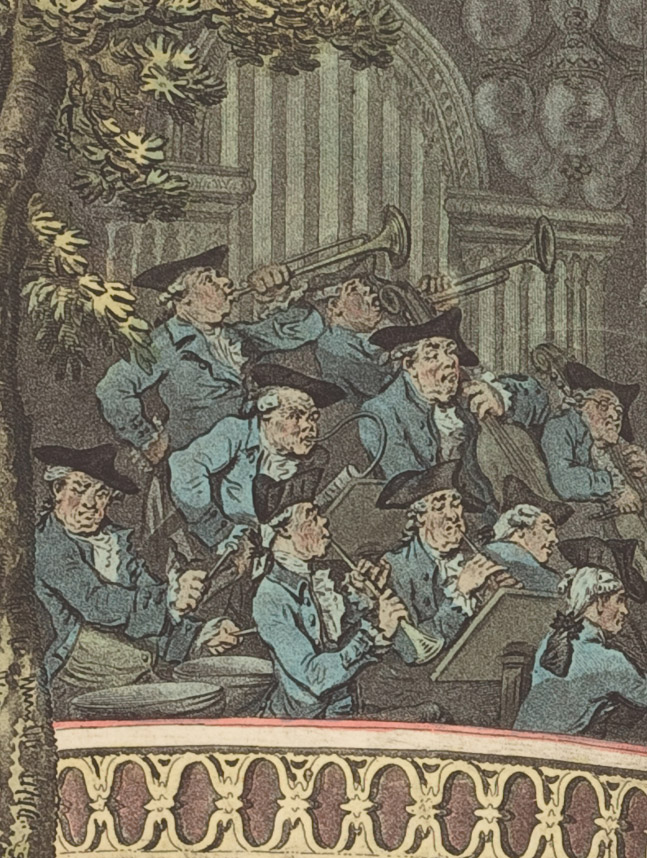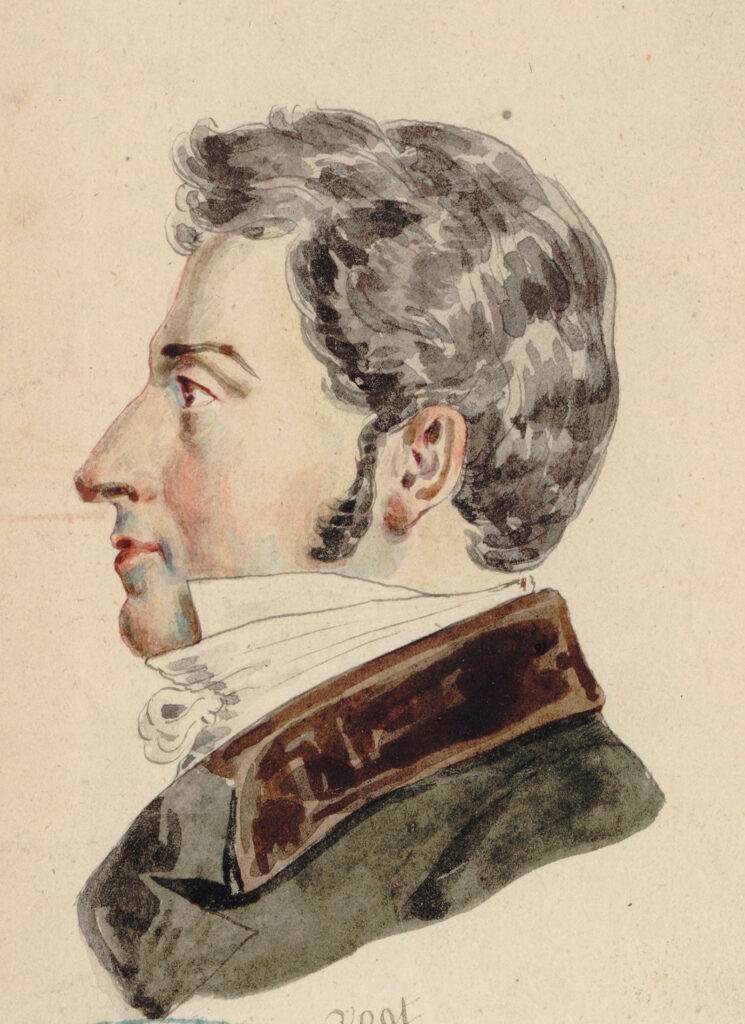Oboe

London was a truly cosmopolitan musical city
at this time.
There was certainly no shortage of excellent oboists in London in the late 18th/early 19th centuries, and leading performers from the UK, Germany, Italy, and France were featured every night in London’s major concert halls, theatres, and pleasure gardens.
From 1760-80 English oboe makers embraced the new “straight top”, slimline-style oboe, which had been introduced to London by Italian musicians. However, following the arrival in London from Germany of celebrity oboist Johann Christian Fischer, the fashion reverted back to the older German cotton reel style oboes. In c.1800 more keys began to be added in the development of the oboe.[1]Picture Credit – Oboe by George Astor 1800. Courtesy of the Rijksmuseum. Public Domain
London’s Premiere Oboists in the 18th & 19th Centuries

Johann Christian Fischer
(1733-1800)
Principal Oboist at Vauxhall Pleasure Gardens from 1768.
Born in Freiburg, Germany in 1733, Fischer had previously been employed in Frederick the Great’s orchestra at Berlin, and played in the Dresden band with Carl Friedrich Abel, who also moved to London. Fischer was one of many German musicians who settled in London in the 18th century, bringing a new and highly regarded style of composing and performing to the UK.
As noted by Dr Charles Burney, Fischer composed “in a style so new and fanciful, that in point of invention as well as tone, taste, expression, and neatness of execution, his piece was always regarded as one of the highest treats of the night, and heard with proportionate rapture.“
Fischer’s oboe concertos were regularly heard at oratorio performances at Covent Garden, Drury Lane, the Haymarket, and the King’s Theatre from 1770-1776.
He also performed at the Professional Concerts, the Concerts of the Nobility, and the New Musical Fund Concerts. In addition, Fischer was concerto performer at Vauxhall Pleasure Gardens.
The oboist John Parke, who succeeded Fischer as a concerto player at Vauxhall, was inspired by Fischer, and credited him as responsible for bringing fresh new ideas to London.
Parke enthused “The tone of Fischer was soft and sweet, and his execution at once neat and brilliant.”
In 1780 Fischer was appointed chamber musician to Queen Charlotte. There was clearly camaraderie at the court concerts, as recounted in the March 1786 edition of Country Magazine, with a tale of a practical joke played on Fischer by young Prince Adolphus during a concert at Windsor Castle during a cadenza. The Prince, hiding under the music desk, “whipt the oboe out of his hands, and left the astonished musician in the attitude of playing, without an instrument.”
On the 29th April 1800, it was while playing a solo in a concert at St James’s Palace, the Queen’s residence, “after having executed his first movement in a style equal to his best performance during any part of his life“, that Fischer suffered a stroke, and died later that evening.[2]Highfill, Philip H., JR, Burnim, Kalman A., Langhans, Edward A. – A Biographical Dictionary of Actors, Actresses, Musicians, Dancers, Managers, & Other Stage Personnel in London 1660-1800. … Continue reading
Fischer resided at No. 40 Dean Street, Soho, London. He was briefly married to Mary Gainsborough, daughter of the artist Thomas Gainsborough, who painted his portrait (pictured)[3]Picture Credit – Johann Christian Fischer (1733-1800), Oboist, by Thomas Gainsborough (1780). Thomas Gainsborough, Public domain, via Wikimedia Commons. Fischer was Governor of the Royal Society of Musicians.

John Parke (1745-1829)
Principal Oboist and Concerto Soloist at Vauxhall Pleasure Gardens from 1771 to c.1804, succeeding the renowned Johann Christian Fischer. Parke is one of the oboists depicted in Rowlandson’s watercolour of 1784 (pictured)[4]Picture Credit: John Parke (1745-1829), Oboist.
Close up of engraving by Francis Jukes after watercolour by Thomas Rowlandson, Public domain, via Wikimedia Commons.
Parke was also Principal Oboe at the King’s Theatre from 1768, and was engaged at the Drury Lane Theatre by David Garrick from 1771, with whom he became close friends.
Much in demand as a musician, Parke had an exclusive post as chamber musician for the Prince of Wales at Carlton House, along with violinist Giardini, pianist Schroeter, and cellist Crosdill. He also played in the Duke of Cumberland’s Band. Extraordinarily, the Duke of Cumberland used to visit Parke’s house in the mornings, and sometimes brought his Band along for a concert.
Prior to performing at Vauxhall Pleasure Gardens, John Parke performed regularly in the bands at other London pleasure gardens, including Ranelagh and Marylebone. He also travelled throughout the UK, attending music meetings at Gloucester, Worcester, Hereford, Liverpool, Manchester, Chester, Birmingham, Oxford, Cambridge, and Norwich.
He lived at No.84 St Martin’s Lane, London.[5]Highfill, Philip H., JR, Burnim, Kalman A., Langhans, Edward A. – A Biographical Dictionary of Actors, Actresses, Musicians, Dancers, Managers, & Other Stage Personnel in London 1660-1800. … Continue reading

William Thomas Parke
(1761-1847)
Principal 2nd Oboist at Vauxhall Pleasure Gardens from 1779.[6]Picture Credit – W. T. Parke (1762-1847), Oboist, by George Dance.
Metropolitan Museum of Art, CC0, via Wikimedia Commons
Younger brother and student of Vauxhall Gardens Principal Oboist John Parke, “Little Parke” (as he was known) also studied piano with Dr Charles Burney, and harmony with the renowned theorist C.F. Baumgarten.
W. T. Parke was Principal 2nd Oboist at Vauxhall Gardens from 1779, alongside his brother John who was 1st Oboe, having previously played the viola and flute there. He became 2nd Oboe at the Drury Lane Theatre from 1777 (having been a soprano chorus singer, then violist there since the age of 14), and Principal Oboe at the Covent Garden Theatre from 1783.
W. T. Parke published his two-volume Musical Memoirs in 1830.
These memoirs are a fascinating (and often amusing) insight into the London concert scene in this period.
Keen to become a successful oboist, W. T. Parke had an ingenious practise regime. He would attach a piece of string to his arm, and dangle it from his bedroom window while sleeping, so the night watchman could pull it to wake him at 4am. He would then practise his oboe in the kitchen until 9am every day.
This hard work clearly paid off. Alongside his brother, John Parke, W. T. Parke performed for the Duke of Cumberland and the Prince of Wales as a member of their private musicians.
W. T. Parke continued to perform regularly at Vauxhall Pleasure Gardens, for example, no less than 40 concerts a season in 1790 and 1791. He succeeded his brother John Parke at Vauxhall, and became Principal Oboist, composer, and soloist in the band at Vauxhall Gardens from 1800 until 1821.
It was noted that “Parke’s tone on the oboe was sweet, his execution brilliant”[7]Middleton, Louisa M. (1895). “Parke, William Thomas“. Dictionary of National Biography. Vol. 43. London: Smith, Elder & Co. p. 230.. He was able to extend the range of the oboe upwards to G, a third higher than former performers had reached[8]Husk, William Henry (1900). “Parke, John” . In Grove, George (ed.). A Dictionary of Music and Musicians. London: Macmillan and Company.
He lived on New Street (now New Row) in Covent Garden, London.[9]Highfill, Philip H., JR, Burnim, Kalman A., Langhans, Edward A. – A Biographical Dictionary of Actors, Actresses, Musicians, Dancers, Managers, & Other Stage Personnel in London 1660-1800. … Continue reading

Johann Friedrich Alexander Griesbach (1769-1825)
The German oboist Griesbach, known as Frederick Griesbach, was born at Coppenbrügge, Hanover, on 2 June 1769. Griesbach came to London in the late 1770s, along with his two elder brothers, and after being instructed on the oboe by Fischer, he became a principal player in the Queen’s band. He also played in the band at the King’s Theatre.
In 1800 Frederick was a Governor of the Royal Society of Musicians, and played the oboe in the Society’s annual concerts at St Paul’s regularly from 1794-1804. He was an oboist with the Philharmonic Society from 1813 -1821. [10]Highfill, Philip H., JR, Burnim, Kalman A., Langhans, Edward A. – A Biographical Dictionary of Actors, Actresses, Musicians, Dancers, Managers, & Other Stage Personnel in London 1660-1800. … Continue reading
Griesbach was probably one of the last of the outstanding players in England to use the old broad “fishtail” reed. He was praised for his clear and powerful tone.[11]An article in The Harmonicon for 1830, cited in Grove’s Dictionary, under “Oboe”
J. Keating
Oboist at Vauxhall Pleasure Gardens in 1840 and 1845. Keating taught oboe at the Royal Academy of Music in 1838, and played with the Philharmonic Society Orchestra in 1840.[12]David Coke –http://www.vauxhallgardens.com/vauxhall_gardens_musicians_page.html
Gaetano Besozzi (1727-1798)
London Oboist. Gaetano Besozzi was born in Parma, and was the son of oboist Giuseppe Besozzi. Besozzi played the oboe for the King’s Theatre in the Haymarket in 1794.
He lived at No 13 Poland Street, Soho, London.[13]Highfill, Philip H., JR, Burnim, Kalman A., Langhans, Edward A. – A Biographical Dictionary of Actors, Actresses, Musicians, Dancers, Managers, & Other Stage Personnel in London 1660-1800. … Continue reading

Gustave Vogt (1781-1870)[14]Picture Credit – Gustave Vogt (1781-1870). Oboist.
Unattributed, Public domain, via Wikimedia Commons
Vogt was a highly successful oboist living in Paris, performing in the Théâtre de l’Ambigu-Comique, Théâtre Feydeau, and the Paris Opera, among others.
He was oboist of Napoleon’s Imperial Guard in the 1805 campaign, and met Joseph Haydn and Ludwig van Beethoven while in Vienna.
Vogt was later invited to perform in London from Paris several times in the early 19th century, including for the London premiére of Beethoven’s Symphony No.9 Op.125, commissioned by the Philharmonic Society, on the 21st March 1825 in the Argyll Concert Rooms, situated on the east side of Regent Street in London.
He was awarded the Order of the Légion d’honneur in 1839.[15]https://en.wikipedia.org/wiki/Gustave_Vogt

Johann Christian Gottlieb Graupner, (1767-1836)
Oboist, double bassist, composer, and music publisher. Johann Christian Gottlieb Graupner was born on 6 October 1767 in Hanover, Prussia. Graupner became a regimental musician. After his discharge from his regiment on 8 April 1788, he came to London.
When in 1791, Franz Joseph Haydn assembled a theatre orchestra, Graupner was first oboist. When Haydn left London, Graupner made the unusual move of sailing to the remote Canadian Province, Prince Edward Island.
In 1795 he went to South Carolina, USA, and played in Church Street Theatre, before moving to Boston and playing in the Federal Street Theatre in 1794.[16]Highfill, Philip H., JR, Burnim, Kalman A., Langhans, Edward A. – A Biographical Dictionary of Actors, Actresses, Musicians, Dancers, Managers, & Other Stage Personnel in London 1660-1800. … Continue reading
John Harrington fl. 1792-1805
Born in Sicily, Harrington was mentioned by Haydn in his first London notebook as a cellist who had played in his London concerts. However, he was a renowned oboist.
On 29 May 1792 Harrington played the oboe in a concert at the Crown and Anchor tavern in the Strand, and during 1793 and 1794 he performed in Salomon’s concerts. In 1794 Harrington also began playing regularly at the King’s Theatre at opera performances
Harrington lived at No. 24 Cumberland Street, Middlesex Hospital, London.[17]Highfill, Philip H., JR, Burnim, Kalman A., Langhans, Edward A. – A Biographical Dictionary of Actors, Actresses, Musicians, Dancers, Managers, & Other Stage Personnel in London 1660-1800. … Continue reading
James John Cornish (1767-1803)
Cornish was born on 26 February 1767. He performed on the oboe, violin, and clarinet at the Theatre Royal in the Haymarket, and at Apollo Pleasure Gardens.
He lived on Stangate Street, Lambeth, London.[18]Highfill, Philip H., JR, Burnim, Kalman A., Langhans, Edward A. – A Biographical Dictionary of Actors, Actresses, Musicians, Dancers, Managers, & Other Stage Personnel in London 1660-1800. … Continue reading
Bibliography & Credits
Researcher – Laura Piras
Contributor – Joel Raymond
Highfill, Philip H., JR, Burnim, Kalman A., Langhans, Edward A. – A Biographical Dictionary of Actors, Actresses, Musicians, Dancers, Managers, & Other Stage Personnel in London 1660-1800. South Illinois University Press, 1975. Volumes: 2, 3, 6, 7 & 11
Middleton, Louisa M. (1895). “Parke, William Thomas”. Dictionary of National Biography. Vol. 43. London: Smith, Elder & Co.
Husk, William Henry (1900). “Parke, John” . In Grove, George (ed.). A Dictionary of Music and Musicians. London: Macmillan and Company.
David Coke’s excellent website
References
| ↑1 | Picture Credit – Oboe by George Astor 1800. Courtesy of the Rijksmuseum. Public Domain |
|---|---|
| ↑2 | Highfill, Philip H., JR, Burnim, Kalman A., Langhans, Edward A. – A Biographical Dictionary of Actors, Actresses, Musicians, Dancers, Managers, & Other Stage Personnel in London 1660-1800. South Illinois University Press, 1975. Volume 5, p.288-291 |
| ↑3 | Picture Credit – Johann Christian Fischer (1733-1800), Oboist, by Thomas Gainsborough (1780). Thomas Gainsborough, Public domain, via Wikimedia Commons |
| ↑4 | Picture Credit: John Parke (1745-1829), Oboist. Close up of engraving by Francis Jukes after watercolour by Thomas Rowlandson, Public domain, via Wikimedia Commons |
| ↑5 | Highfill, Philip H., JR, Burnim, Kalman A., Langhans, Edward A. – A Biographical Dictionary of Actors, Actresses, Musicians, Dancers, Managers, & Other Stage Personnel in London 1660-1800. South Illinois University Press, 1975. Volume 11, p.209-11 |
| ↑6 | Picture Credit – W. T. Parke (1762-1847), Oboist, by George Dance. Metropolitan Museum of Art, CC0, via Wikimedia Commons |
| ↑7 | Middleton, Louisa M. (1895). “Parke, William Thomas“. Dictionary of National Biography. Vol. 43. London: Smith, Elder & Co. p. 230. |
| ↑8 | Husk, William Henry (1900). “Parke, John” . In Grove, George (ed.). A Dictionary of Music and Musicians. London: Macmillan and Company. |
| ↑9 | Highfill, Philip H., JR, Burnim, Kalman A., Langhans, Edward A. – A Biographical Dictionary of Actors, Actresses, Musicians, Dancers, Managers, & Other Stage Personnel in London 1660-1800. South Illinois University Press, 1975. Volume 11, p.211-213 |
| ↑10 | Highfill, Philip H., JR, Burnim, Kalman A., Langhans, Edward A. – A Biographical Dictionary of Actors, Actresses, Musicians, Dancers, Managers, & Other Stage Personnel in London 1660-1800. South Illinois University Press, 1975. Volume 6, p.371-2 |
| ↑11 | An article in The Harmonicon for 1830, cited in Grove’s Dictionary, under “Oboe” |
| ↑12 | David Coke –http://www.vauxhallgardens.com/vauxhall_gardens_musicians_page.html |
| ↑13 | Highfill, Philip H., JR, Burnim, Kalman A., Langhans, Edward A. – A Biographical Dictionary of Actors, Actresses, Musicians, Dancers, Managers, & Other Stage Personnel in London 1660-1800. South Illinois University Press, 1975. Volume 2, p.71 |
| ↑14 | Picture Credit – Gustave Vogt (1781-1870). Oboist. Unattributed, Public domain, via Wikimedia Commons |
| ↑15 | https://en.wikipedia.org/wiki/Gustave_Vogt |
| ↑16 | Highfill, Philip H., JR, Burnim, Kalman A., Langhans, Edward A. – A Biographical Dictionary of Actors, Actresses, Musicians, Dancers, Managers, & Other Stage Personnel in London 1660-1800. South Illinois University Press, 1975. Volume 6, p.313 |
| ↑17 | Highfill, Philip H., JR, Burnim, Kalman A., Langhans, Edward A. – A Biographical Dictionary of Actors, Actresses, Musicians, Dancers, Managers, & Other Stage Personnel in London 1660-1800. South Illinois University Press, 1975. Volume 7, p.121 |
| ↑18 | Highfill, Philip H., JR, Burnim, Kalman A., Langhans, Edward A. – A Biographical Dictionary of Actors, Actresses, Musicians, Dancers, Managers, & Other Stage Personnel in London 1660-1800. South Illinois University Press, 1975. Volume 3, p.508 |